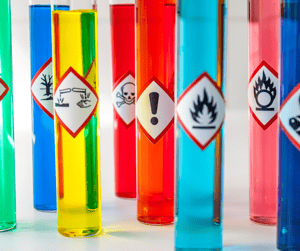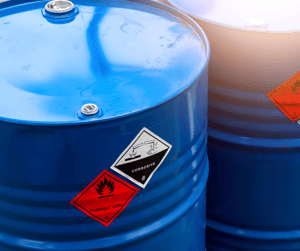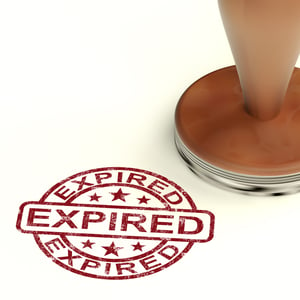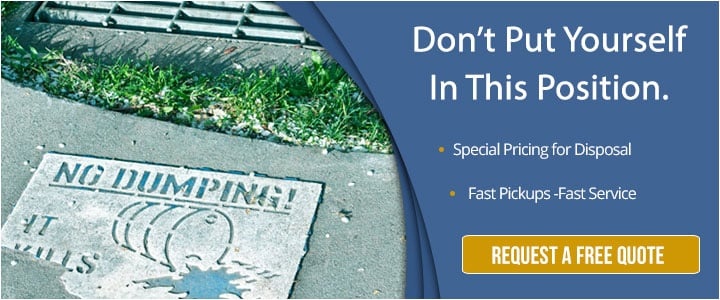The last thing that you want to do is get a phone call in the early hours of the morning, letting you know that the facility you manage had a catastrophic explosion. The building is destroyed, there are casualties, and the surrounding community has been affected.
Managing the chemicals stored in your warehouse, manufacturing facility or laboratory is serious business. If they are not handled and stored properly, a catastrophe could be waiting to happen.
The good news is by taking some simple steps and prioritizing how the chemicals in your facility are stored; you can prevent this nightmare scenario from ever happening.
Here are 10 best practices for proper chemical storage to help keep your employees safe:
- Separate incompatible chemicals.
- Use proper storage cabinets.
- Choose containers that won’t break.
- Never store chemicals on the floor.
- Never store chemicals too high.
- Attach shelving to the wall.
- Add anti-roll lips to shelves.
- Label everything carefully.
- Remove expired chemicals.
- Inspect, and then inspect again.
Separate Incompatible Chemicals
Proper chemical storage helps to ensure safety in any laboratory, industrial or educational setting. One of the most crucial best practices is to separate incompatible chemicals. This practice prevents dangerous reactions that could lead to fires, explosions or the release of toxic gases.
crucial best practices is to separate incompatible chemicals. This practice prevents dangerous reactions that could lead to fires, explosions or the release of toxic gases.
Incompatible materials, when stored together, can react violently with each other, posing severe risks to health, safety and property. These reactions can occur unexpectedly, even with small amounts of contaminants, leading to catastrophic consequences. By segregating these substances, you reduce the risk of accidental contact and subsequent hazardous reactions.
Here are some common examples of incompatible chemicals:
- Acids and Bases: When acids (e.g., hydrochloric acid) come into contact with bases (e.g., sodium hydroxide), they can produce exothermic reactions, releasing heat and potentially causing violent boiling or splattering.
- Oxidizers and Flammables: Oxidizing agents (e.g., hydrogen peroxide, potassium permanganate) can cause flammable materials (e.g., alcohols, gasoline) to ignite or explode, even without an external ignition source.
- Reactive Metals and Water: Metals like sodium, potassium and lithium react vigorously with water, producing flammable hydrogen gas and heat, which can lead to explosions.
- Chlorine and Ammonia: Mixing chlorine bleach with ammonia-based cleaners results in the formation of chloramine vapors, which are highly toxic and can cause respiratory distress and other health issues.
When incompatible chemicals come into contact, the results can be devastating. Here are four potential outcomes:
- Fire and Explosion: Certain combinations, such as oxidizers with flammables, can lead to intense fires or explosions.
- Toxic Gas Release: Reactions like those between acids and cyanides or sulfides can release highly toxic gases (hydrogen cyanide or hydrogen sulfide, respectively), posing immediate and severe health risks to anyone in the vicinity.
- Corrosive Spills: Mixing acids with bases can result in corrosive splashes or spills, which can damage surfaces, equipment, and cause severe injuries such as chemical burns.
- Pressure Build-Up: Some reactions produce gases that can build up pressure in sealed containers, potentially causing them to rupture and release hazardous materials.
To effectively separate incompatible chemicals, designate and label storage areas for different classes of chemicals. Use signs and color-coded systems to indicate incompatibilities. Store chemicals in trays or secondary containers that can contain leaks or spills as well, preventing them from reaching other substances.
Maintaining and regularly updating a chemical segregation chart, which outlines incompatibilities and recommended storage practices, can help to ensure all chemicals at your facility are properly segregated.
Use Proper Storage Cabinets
Storage cabinets are common in laboratories, manufacturing facilities and factories. However, if your facility uses dangerous chemicals, special industrial cabinets are needed to mitigate risks associated with hazards.
Chemical storage cabinets are specifically designed to contain spills, reduce exposure to fumes and provide a robust barrier against fires. Using the correct type of storage cabinet for each chemical category, whether flammable liquids, corrosives or poisons, ensures that the substances are stored in a manner that minimizes risk.
Flammable and combustible chemicals, for example, should be stored in fire-resistant cabinets that comply with safety standards like the National Fire Protection Association (NFPA) and Occupational Safety and Health Administration (OSHA) regulations. These flammable storage cabinets are constructed to withstand high temperatures and prevent the liquid chemicals inside from contributing to a fire.
Corrosive substances require cabinets made of materials resistant to acid or base corrosion. These corrosive cabinets help prevent leaks and spills that can damage facilities and harm personnel.
In addition to the physical protection offered by these cabinets, proper labeling and organization within the cabinets are crucial. Clearly marked labels indicating the type of chemical and associated hazards can prevent accidental misuse and ensure quick identification in case of an emergency.
Choose Containers That Won’t Break
The containers you choose to store chemicals in are important considerations as well. It’s crucial to store flammable liquids and other potentially toxic substances in containers made of materials that are compatible with the chemical they hold, reducing the risk of reactions that could lead to breakage or leakage.
liquids and other potentially toxic substances in containers made of materials that are compatible with the chemical they hold, reducing the risk of reactions that could lead to breakage or leakage.
For example, strong acids should be stored in glass or specific types of plastic that resist corrosion, while flammable solvents are best kept in metal containers designed to prevent ignition.
In addition to material compatibility, complying with regulations regarding the size and type of containers used for certain chemicals is important. Regulatory bodies like OSHA and the U.S. Environmental Protection Agency (EPA) have guidelines that dictate the maximum allowable container size for specific hazardous substances to mitigate risks associated with spills, leaks and exposure.
Following these regulations not only enhances safety but also ensures compliance with legal standards, avoiding potential fines and legal issues.
Make sure you regularly inspect containers for signs of wear, such as cracks, corrosion or degradation. Replacing damaged containers promptly prevents accidental spills and exposure, maintaining a safer storage environment.
Never Store Chemicals On The Floor
Storing chemicals on the floor is a hazardous practice that should always be avoided.
Chemicals stored at ground level are more prone to accidental spills, leaks and contamination. They are also at greater risk of being knocked over or damaged by foot traffic, equipment movement or cleaning activities.
Instead, chemicals should be stored on shelves or in designated storage cabinets that are sturdy and secure. Elevated storage not only reduces the risk of accidental spills but also makes it easier to manage and organize chemicals properly. However, in the next section, we’ll go over why “elevated” should not necessarily mean “too high.”
Never Store Chemicals Too High
Storing chemicals too high on shelves poses a risk as well. When chemicals are placed above eye level, it becomes difficult to see labels clearly, increasing the chances of grabbing the wrong substance.
Reaching for high shelves can lead to spills or accidents as well, especially if containers are heavy or awkward to handle. The risk of containers falling and causing injury or chemical exposure is heightened as well.
Chemicals should be stored at or below eye level, making it easier to read labels and access them without straining. This positioning ensures that chemicals can be handled more securely and reduces the likelihood of accidents.
Attach Shelving To The Wall
Securing shelving units to the wall is a crucial safety measure in any environment where chemicals are stored. Properly anchored shelves provide stability and prevent tipping or collapsing, which can occur due to the weight of stored chemicals, accidental bumps or natural events like earthquakes.
Properly anchored shelves provide stability and prevent tipping or collapsing, which can occur due to the weight of stored chemicals, accidental bumps or natural events like earthquakes.
Ensuring that shelves are firmly attached to the wall significantly reduces the risk of potentially dangerous spills, leaks and injuries caused by falling chemicals.
Wall-mounted shelving also helps maintain an organized and efficient workspace. By securely fastening shelves, you can store chemicals in a more orderly manner, maximizing vertical space without compromising safety.
Add Anti-Roll Lips To Shelves
Adding anti-roll lips are raised edges or barriers on the front and sides of shelves. They prevent containers from accidentally sliding off, especially during vibrations or minor impacts.
Anti-roll lips are particularly important in areas prone to movement or where containers are frequently accessed, providing an extra layer of security against spills and breakages.
Anti-roll lips also contribute to better organization and accessibility of stored chemicals. By keeping containers securely in place, these barriers help maintain a tidy storage environment, making it easier to locate and retrieve chemicals without disturbing adjacent containers.
Label Everything Carefully
Clear, accurate labels provide essential information at a glance, helping to prevent accidents.
Each label should include key details such as the chemical name, concentration, hazard warnings, date of receipt and expiration date. Labels should be resistant to chemicals and moisture to remain legible over time.
When labeling chemical containers, consider the following:
- Chemical Name: Use the full chemical name rather than abbreviations or formulas to avoid confusion.
- Concentration: Specify the concentration to inform users about the strength of the chemical solution.
- Hazard Warnings: Include appropriate hazard symbols and phrases to indicate potential risks (e.g., flammable, corrosive, toxic).
- Date of Receipt: Note when the chemical was received to track its age and prioritize older stock.
- Expiration Date: Clearly mark the expiration date to ensure chemicals are used within their safe and effective period.
- Storage Instructions: Provide any special storage conditions required (e.g., keep refrigerated, protect from light).
By carefully labeling everything, you enhance safety, ensure proper handling and facilitate quick identification in case of emergencies. Make sure any chemical waste labels are properly filled out as well.
Remove Expired Chemicals
Regularly removing expired chemicals is a vital practice. Chemicals that have passed their expiration date can degrade, becoming unstable or less effective, and in some cases, they can pose serious safety hazards.
degrade, becoming unstable or less effective, and in some cases, they can pose serious safety hazards.
Degraded chemicals may react unpredictably, potentially leading to leaks, spills or dangerous reactions. To mitigate these risks, establish a routine schedule for checking expiration dates and promptly disposing of any outdated substances.
You should conduct a thorough inventory check at least twice a year, carefully inspecting each chemical container for expiration dates. However, the specific chemicals you have onsite may warrant more frequent checks.
When expired chemicals are identified, ensure they are disposed of correctly through a hazardous waste disposal company. These companies specialize in the safe handling and disposal of hazardous materials, adhering to strict regulatory standards to protect human health and the environment.
Partnering with a certified hazardous waste disposal service guarantees that expired chemicals are managed responsibly, reducing the risk of improper disposal and ensuring compliance with legal requirements.
Inspect, And Then Inspect Again
Routine inspections are a cornerstone of maintaining a safe and effective chemical storage environment. Regularly checking your storage areas helps identify potential hazards before they become serious issues.
Inspections should be conducted systematically and thoroughly, focusing on the condition of the containers, the storage area and adherence to safety protocols. By catching problems early, you can take corrective actions that prevent accidents, spills and contamination.
During routine inspections, watch out for the following:
- Container Integrity: Look for signs of damage, corrosion or leaks in containers. Replace any compromised containers immediately.
- Label Legibility: Ensure all labels are clear, intact and provide necessary information. Replace any labels that are fading or peeling.
- Proper Segregation: Verify that incompatible chemicals are stored separately to prevent dangerous reactions.
- Storage Conditions: Check that storage conditions, such as temperature and humidity, meet the requirements for each chemical.
- Shelf Stability: Ensure that shelves are securely attached to walls and that anti-roll lips are in place and effective.
- Expired Chemicals: Identify and remove any expired chemicals, ensuring they are disposed of correctly.
- Spill Containment: Confirm that spill containment measures, like secondary containment trays, are in place and in good condition.
- Emergency Equipment: Verify that emergency equipment, such as eyewash stations and fire extinguishers, is accessible and functioning properly.
Regularly conducting these inspections, and following up on any issues found, helps maintain a high standard of safety and compliance in your chemical storage areas. This proactive approach ensures that potential risks are managed effectively, protecting personnel, property and the environment.
A workable plan and diligence on the part of management and employees can keep everyone safe.
- SEO Powered Content & PR Distribution. Get Amplified Today.
- PlatoData.Network Vertical Generative Ai. Empower Yourself. Access Here.
- PlatoAiStream. Web3 Intelligence. Knowledge Amplified. Access Here.
- PlatoESG. Carbon, CleanTech, Energy, Environment, Solar, Waste Management. Access Here.
- PlatoHealth. Biotech and Clinical Trials Intelligence. Access Here.
- Source: https://blog.idrenvironmental.com/the-top-10-best-practices-for-proper-chemical-storage

